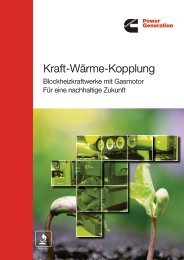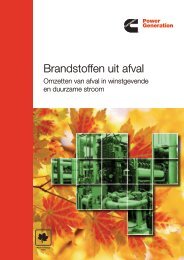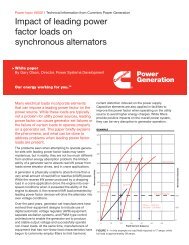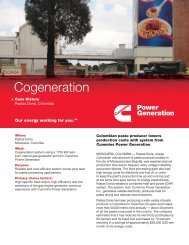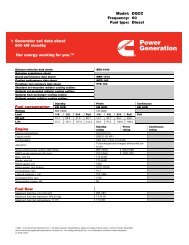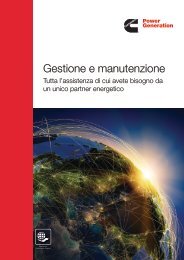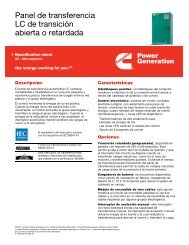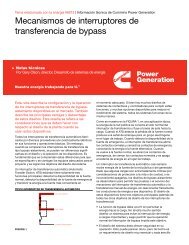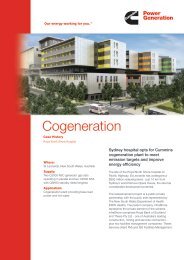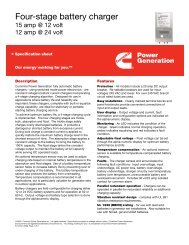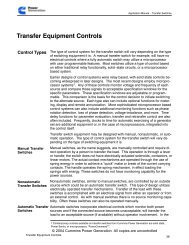appendix
appendix
appendix
You also want an ePaper? Increase the reach of your titles
YUMPU automatically turns print PDFs into web optimized ePapers that Google loves.
Application Manual – Liquid Cooled Generator Sets<br />
Cycle<br />
A cycle is one complete reversal of an alternating current or voltage—from zero to a<br />
positive maximum to zero again and then from zero to a negative maximum to zero<br />
again. The number of cycles per second is the frequency.<br />
dB/dB(A) Scale<br />
The decibel (dB) scale used in sound level measurements is logarithmic. Sound level<br />
meters often have several decibel weighting scales (A, B,C). The A–scale, dB(A), is the<br />
most commonly used weighting scale for measuring the loudness of noise emitted from<br />
generator sets.<br />
Delta Connection<br />
Delta connection refers to a three–phase connection in which the start of each phase is<br />
connected to the end of the next phase, forming the Greek letter Δ.. The load lines are<br />
connected to the corners of the delta.<br />
Demand Factor<br />
The demand factor is the ratio of actual load to the potential total connected load.<br />
Deviation Factor<br />
The deviation factor is the maximum instantaneous deviation, in percent, of the generator<br />
voltage from a true sine wave of the same RMS value and frequency.<br />
Dielectric Strength<br />
Dielectric strength is the ability of insulation to withstand voltage without rupturing.<br />
Direct Current (DC)<br />
Direct current is current with no reversals in polarity.<br />
Differential Relay<br />
A differential relay is a protective device which is fed by current transformers located at<br />
two different series points in the electrical system. The differential relay compares the<br />
currents and picks up when there is a difference in the two which signifies a fault in the<br />
zone of protection. These devices are typically used to protect windings in generators or<br />
transformers.<br />
Earthing<br />
Earthing is the intentional connection of the electrical system or electrical equipment<br />
(enclosures, conduit, frames, etc.) to earth or ground.<br />
Efficiency (EFF)<br />
Efficiency is the ratio of energy output to energy input, such as the ratio between the<br />
electrical energy input to a motor and the mechanical energy output at the shaft of the<br />
motor.<br />
Emergency System<br />
An emergency system is independent power generation equipment that is legally required<br />
to feed equipment or systems whose failure may present a life safety hazard to persons<br />
or property.<br />
Energy<br />
Energy is manifest in forms such as electricity, heat, light and the capacity to do work. It<br />
is convertible from one form to another, such as in a generator set, which converts<br />
rotating mechanical energy into electrical energy. Typical units of energy are kW•h, BTU<br />
(British thermal unit), Hp•h, ft•lbf, joule, and calorie.<br />
Exciter<br />
An exciter is a device that supplies direct current (DC) to the field coils of a synchronous<br />
generator, producing the magnetic flux required for inducing output voltage in the<br />
armature coils (stator). See Field.<br />
G–4 APPENDIX G<br />
Rev. Jan 2011



